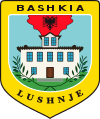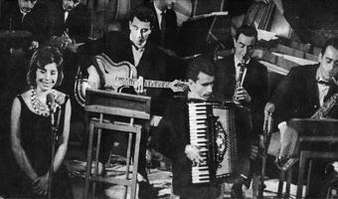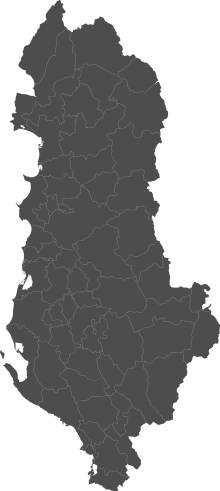Lushnjë
| Lushnjë | ||
|---|---|---|
| Municipality | ||
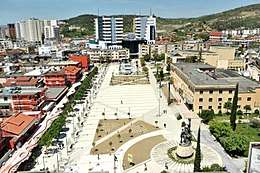 | ||
| ||
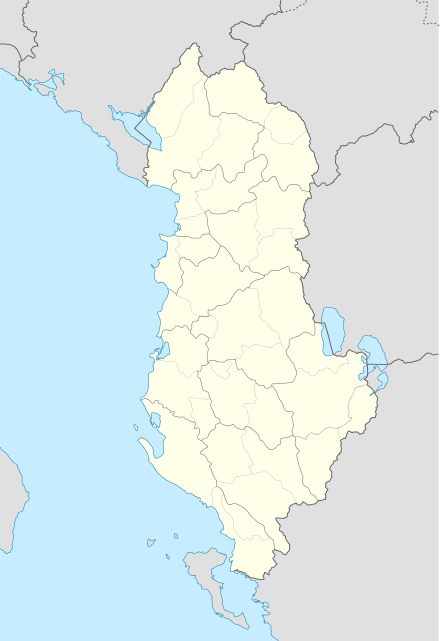 Lushnjë | ||
| Coordinates: 40°56′N 19°42′E / 40.933°N 19.700°E | ||
| Country |
| |
| County |
| |
| Government | ||
| • Mayor | Fatos Tushe (PS) | |
| Area | ||
| • Municipality | 372.72 km2 (143.91 sq mi) | |
| Elevation | 9 m (30 ft) | |
| Population (2016) | ||
| • Administrative Unit | 31,105 | |
| Demonym(s) | Lushnjar/e | |
| Time zone | UTC+1 (CET) | |
| • Summer (DST) | UTC+2 (CEST) | |
| Postal Code | 9001 | |
| Area Code | (0)35 | |
| Vehicle registration | AL | |
| Website | Official Website | |
Lushnjë (Albanian pronunciation: [ˈluʃɲə], in Lushnje's own dialect Lushnje [ˈluʃɲe], definite Albanian form: Lushnja) is a city in west-central Albania. It is located in the County of Fier. The total population is 83,659 (2011 census), in a total area of 372.72 km2.
History
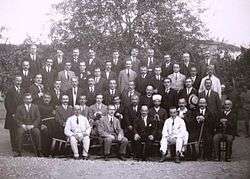
In January 1920, Lushnje was a provisional capital of Albania and the place of the Congress of Lushnje. Chieftains of Albania assembled in the town and declared Tirana first a provisional and then the definitive capital of Albania.
3 km away from Lushnjë is the Savra Field. This field is on the Lushnjë-Fier road. Here the first battle between Principality of Zeta and Ottoman Empire occurred in 1385 (the Battle of Savra). In this battle Balsha II was killed. Along with Fier, Lushnjë was the main district of the concentration camps during the Communist Regime; some of the camps included the villages of Savër, Gradishtë, Bedat, Gjazë, Rrapëz, Plug, etc.
Historic Battles
Economy
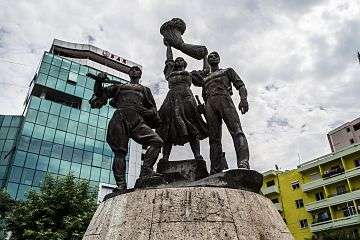
The Lushnje region is known as a main provider of agricultural products to the rest of the country, and home to a national Institute of Agricultural Research.[1] During the Communist Regime the town had a number of factories: among them food processing and building materials, which were closed down for one reason or another in the aftermath of the fall of Communism. There are many companies for food transportation that take their fruits and vegetables towards European Countries with trucks. Two of the biggest food distribution brands in Lushnje are Elkos Agrar and Doni Fruits. Also there are a small companies that procedure olive oil. There has been a rise of gas and bricks. Many gas companies have created oil tanks due to the need of gas to supply cars and farming vehicles. The bricks in Lushnje are mainly produced in villages by hills. One of the biggest factory for bricks is Allprenaj. It has good roads to have goods from other countries that come to the Port of Durres and from Greece. With the SH4 highway. There is good trade with villages with many village roads that will take villagers to Lushnje to sell their goods with a small percentage of farmers from Fier. The main villages that produce the most crops is Krutje and Fier-Shegan. Due to tourists coming to Divjaka Karavasta National Park there have been tourist coming to Lushnje for the food and many scientist that get paid by UNESCO to help animals so they don't turn extinct. There is also a lot of businesses that help the cities development in taxes. There are many cafes, bars, restaurants, hotels, shopping malls, and major supermarket brands and small convince stores. Therefore the economy in Lushnje is very high. Many of it comes from agriculture due lushnje being an major agricultural hub and is growing for many years with better road infrastructure for farmers to sell there goods and crops. And with many building materials, oil, and business.
Demographics
Like most southern Albanian regions, the people of Lushnje speak a Tosk dialect. The population is mixed Orthodox and Muslim, typical of southern Albanian cities. Data from the 1918 census shows that the population of Lushnje was split almost evenly between Muslims and Christians at the time of independence from the Ottoman Empire.[2] The Christians are mostly Orthodox, but there is a Catholic minority, while similarly the Muslims are mostly Sunni with a Bektashi minority. In modern days, like elsewhere in Albania, people in Lushnja tend not to be very religious if religious at all, regardless of whatever religion their ancestors professed.
Sport
KS Lushnja The club was originally formed in 1927 and the first football game held in the city of Lushnje was played shortly after. This was a friendly game against FK Tomori Berat and the team consisted of young men from Lushnje. The club was named Kongresi i Lushnjës following a proposal from a member of parliament and signatory of the Albanian Declaration of Independence Ferit Vokopola to name the club after the Congress of Lushnje, which was where Vokopola himself was elected secretary. In 1927 a young man named Ali Fuga returned from his studies in Austria and joined the club as a player and the head coach. He returned to Albania from Austria with shirts that would be used by the club, and they had green vertical stripes which were used to symbolise the fields of Myzeqe. Although the club was formed on 21 January 1927 it was not "officially" formed until 27 July 1930 shortly after the formation of the Albanian Football Association a month earlier. It was known then as the Kongresi i Lushnjës literacy-artistic society. The club's first official jerseys were green, and the first sports chief of the club was Ali Fuga, who had been a key member of the club's pre formation years. In 1945 they changed their name to KS Traktori Lushnja followed by a further name change in 1950 to SK Lushnja. In 1951 it was changed to Puna Lushnja, before they returned to KS Traktori Lushnja in 1958. In 1991 the club was named KF Lushnja. The club's main supporters' group is called the Ultras Delegatët. Also Lushnje has their own Volleyball team known as Ekipi Volejbolli e Lushnjes.
Mayors of Lushnja Municipality

- Kujtim Haxhiu 1992-1996
- Agim Fuga 1996-2000
- Ylli Myftiu 2000-2003
- Kadri Gega 2003-2007
- Albert Sanxhaku 2007-2011
- Fatos Tushe 2011-2019
Notable landmarks
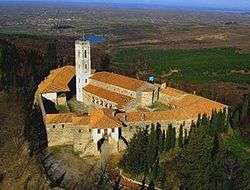
- Abdurrahman Roza Haxhiu Stadium
- Congress of Lushnje Museum
- Ardenica Monastery
- Toka Jone Monument
- Muzeu Historik Lushnje
Geography
.jpg)
Lushnje is in a hot Mediterranean summer type of climate. Lushnje is in the middle plains and flatland. This land is used for growing crops and raising animals. It is 30km to Divjakë-Karavasta National Park with wetland and beaches and a lagoon[3]. There is a Reservoir in a village in Kashar, Lushnje with many farmlands around it and a connecting canal known as Perrio. Lushnje also has a lot of olive oil trees with one of the most places in Albania to produce olive oil.
Subdivisions
Allkaj, Ballagat, Bubullimë, Dushk, Fier-Shegan, Golem, Hysgjokaj, Karbunarë, Kolonjë, Krutje, Lushnje
Skyline
Lushnje has many Residential buildings that are located on the major boulevard known as the Shetitorija. The tallest building in the city is located at Shetitorija i Kongresi Lushnjes. The building is a residential building. Most of the city is filled with 10 to 20 story tall buildings. The most modern building is the Metropol Center and the ABC Art & Businesses Center with a glass structure. The Metropol Center is the biggest mall in the region and Southern Albania and the ABC Art & Businesses Center is the first modern glass structure in Lushnje and the first modern structure in Lushnje.
Education
Lushnje has many schools from college and to pre-k. The most biggest and most famous schools in Lushnje are known as "Skënder Libohova", "18 Tetori" and "Kongresi i Lushnjes". "Kongresi i Lushnjes" has been renovated and is one for the most modern schools in the city with painted sides and interior upgrades. The college that is situated in Lushnje is Institute of Agricultural Research Lushnje about agriculture research. "Foto Puka" is another school in the city that is the second largest one. There are two high schools, one is "18 Tetori" and the other being "Vath Koreshi".
School Recreation
The schools of Lushnje offer a lot of recreation for their students. "Skënder Libohova" school has a new multi-functional park and a basketball and soccer area. "Foto Puka" and "Jani Nushi" are more known for their soccer and volleyball respectively.
Transportation

Highways
There is one highway that passes by the outskirts of Lushnje known as the SH4. The SH4 comes from Durrës to Lushnje, and then to Fier.
Bus
There are urban buses through the city with only one straight route. The urban bus goes from the roundabout in Plug, Lushnje, through Lushnje, and to Karbunarë, Lushnje. The ride is about 5 km and 13 minutes or less. There are buses available at the train station which can take you from Lushnje to Greece and many places in the country and Balkan region.
Trains
Due to the shutdown of trains in Albania during 1990 there have been no signs of trains.[4]
The Emblematic Figure of Lushnje
- Vaçe Zela - Song, Queen and Albanian Song
- Abdurrahman Roza Haxhiu - Footballer,Trainer,Martyrs of the Blessed Albanian Field
- Margarita Xhepa - Actor
- Vath Koreshi - Writer
- Ilia Shyti - Actress
Notable people
Following is a list of notable people born in Lushnja, Albania, or that spent most of their lives in Lushnja.
(1939-2014)
- Bajram Haxhiu - patriot, member of the initiating commission of the Lushnja Congress
- Nebi Efendi Sefa - one of the founding fathers of modern Albania, signed the declaration of independence in 1912
- Ferit bej Vokopola - one of the founding fathers of modern Albania, signed the declaration of independence in 1912
- Sheh Ibrahim Karbunara - patriot
- Qerim Haxhiu - patriot
- Kaso Fuga - patriot
- Pavlina Mani - actress
- Loni Papa - writer
- Kristaq Dhamo - movie's director
- Hasan Dervishi - actor
- Athina Dhimitri (Vogli) - actress
- Visar Zhiti - writer
- Lindita Arapi - poet, writer
- Erik Lloshi - singer
- Luli Bitri - actress
- Gjergji Lala - actor, director
- Dhimitraq Nushi - actor
- Hekuran Zhiti - actor
- Petraq Dhimitri - actor
- Fahredin Nuri - engineer
- Kastro Zizo - musician
- Iljaz Çeço - football player
- Artan Bano - football player and manager
- Rezart Dabulla - football player
- Saimir Malko - football player and manager
- Edmond Dalipi - football player
- Rey Manaj - football player
Twin towns - Sister cities
References
- ↑ Tatjana Dishnica on the history of the scientific agricultural institutes of Albania
- ↑ Siegfried Gruber. "Regional variation in marriage patterns in Albania at the beginning of the 20th century". www-gewi.uni-graz.at. Retrieved 2014-06-11. , Seiner's 1918 data mapped here: http://www-gewi.uni-graz.at/seiner/density.html
- ↑
- ↑
External links
| Wikimedia Commons has media related to Lushnjë. |
